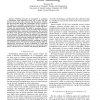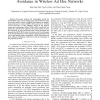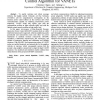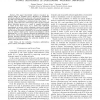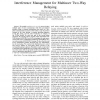76
Voted
MOBIQUITOUS
2007
IEEE
15 years 7 months ago
2007
IEEE
— Wireless networks are susceptible to accidental or intentional radio interference. One way to cope with this threat is to have the radios compete with the jammer, whereby the n...
106
click to vote
ICC
2007
IEEE
15 years 7 months ago
2007
IEEE
—The paper analyzes the relationships among the transmission range, carrier sensing range, and interference range in case that power control is adopted and proposes an adaptive r...
112
click to vote
ICC
2007
IEEE
15 years 7 months ago
2007
IEEE
— To enable real-time and robust message delivery, the highly mobile Vehicular Ad Hoc Networks (VANETs) call for comprehensive investigation on the dynamic power control effects ...
121
Voted
GLOBECOM
2007
IEEE
15 years 7 months ago
2007
IEEE
Abstract— This paper theoretically analyzes cross-layer optimized design of transmit power allocation in distributed interference-limited wireless networks with asynchronously ac...
89
Voted
GLOBECOM
2007
IEEE
15 years 7 months ago
2007
IEEE
Abstract—In wireless networks, monotonic, strictly subhomogeneous functions have been used to analyze power control algorithms. We provide an alternative analysis based on the ob...
133
click to vote
GLOBECOM
2007
IEEE
15 years 7 months ago
2007
IEEE
— The problem of non-cooperative power control is studied for wireless ad hoc networks supporting data services. We develop a maximum throughput based non-cooperative power contr...
PIMRC
2008
IEEE
15 years 7 months ago
2008
IEEE
— The inherent near-far effect in wireless networks causes nodes that are further away from the receiver to suffer from throughput degradation, as packets from nodes that are nea...
117
Voted
ICASSP
2008
IEEE
15 years 7 months ago
2008
IEEE
Transmit-power control is a critical task in cognitive radio (CR) networks. In the present contribution, adherence to hierarchies between primary and secondary users in a peer-to-...
133
click to vote
GLOBECOM
2008
IEEE
15 years 7 months ago
2008
IEEE
—We consider the problem of joint routing, scheduling and power control in multi-hop wireless networks. We use a linear relation between link capacity and signal to interference ...
85
Voted
CISS
2008
IEEE
15 years 7 months ago
2008
IEEE
—We consider a multiuser two-way relay network where multiple pairs of users communicate with their pre-assigned partners, using a common intermediate relay node, in a twophase c...
